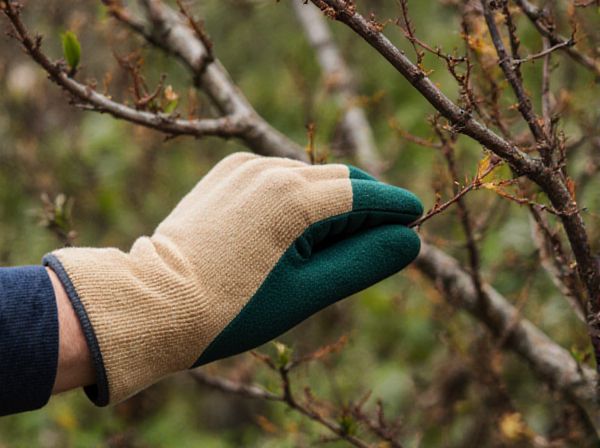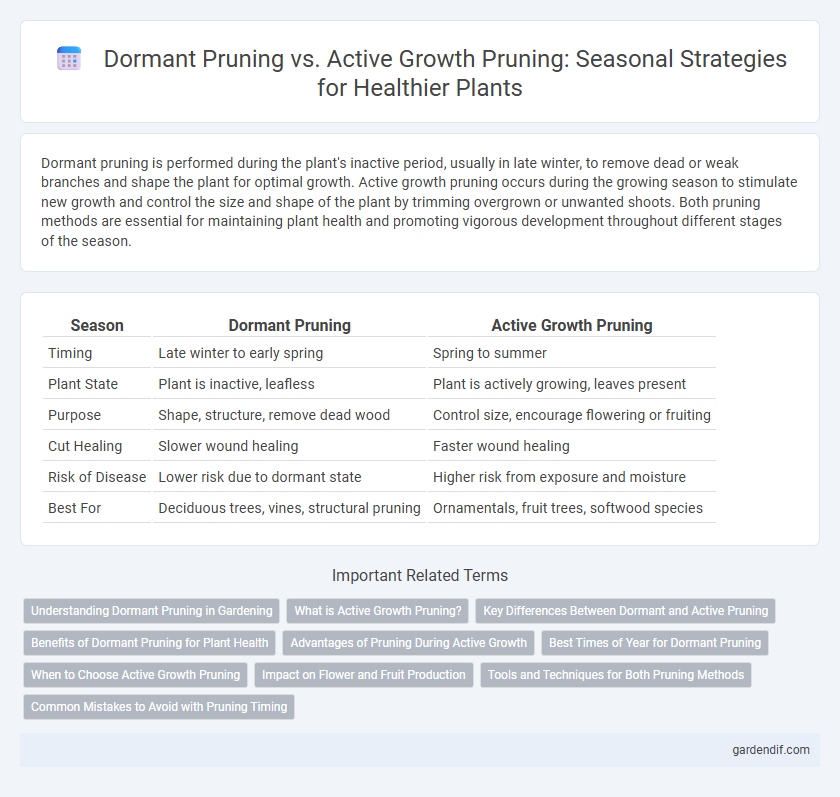
Dormant pruning vs Active growth pruning Illustration
Dormant pruning is performed during the plant's inactive period, usually in late winter, to remove dead or weak branches and shape the plant for optimal growth. Active growth pruning occurs during the growing season to stimulate new growth and control the size and shape of the plant by trimming overgrown or unwanted shoots. Both pruning methods are essential for maintaining plant health and promoting vigorous development throughout different stages of the season.
Table of Comparison
| Season | Dormant Pruning | Active Growth Pruning |
|---|---|---|
| Timing | Late winter to early spring | Spring to summer |
| Plant State | Plant is inactive, leafless | Plant is actively growing, leaves present |
| Purpose | Shape, structure, remove dead wood | Control size, encourage flowering or fruiting |
| Cut Healing | Slower wound healing | Faster wound healing |
| Risk of Disease | Lower risk due to dormant state | Higher risk from exposure and moisture |
| Best For | Deciduous trees, vines, structural pruning | Ornamentals, fruit trees, softwood species |
Understanding Dormant Pruning in Gardening
Dormant pruning occurs during a plant's inactive phase, typically in late winter, to remove dead or diseased branches and shape the structure before new growth begins. This method minimizes stress on the plant by targeting a period when metabolic activity is low, enhancing overall health and encouraging vigorous spring growth. Understanding the timing and techniques of dormant pruning is crucial for gardeners aiming to optimize plant development and yield.
What is Active Growth Pruning?
Active growth pruning involves trimming plants during their growing season to promote healthy development and increase fruit or flower production. This method targets removing weak or overcrowded branches to improve air circulation and sunlight penetration, which enhances overall plant vigor. Timing and precision are crucial for active growth pruning to avoid stress and encourage optimal growth.
Key Differences Between Dormant and Active Pruning
Dormant pruning occurs during a plant's inactive phase, typically in late winter, targeting dead or weak branches to prepare for vigorous spring growth. Active growth pruning is done during the growing season, focusing on shaping and controlling the plant's size while promoting healthy development. Key differences include timing, purpose, and impact on plant physiology, with dormant pruning promoting structural strength and active growth pruning enhancing immediate growth patterns.
Benefits of Dormant Pruning for Plant Health
Dormant pruning enhances plant health by promoting stronger structural development and reducing the risk of disease transmission during the inactive season. By removing dead or weak branches before new growth begins, plants can allocate energy efficiently to vigorous shoots in spring. This practice also improves air circulation and sunlight penetration, crucial factors for preventing fungal infections and supporting overall vitality.
Advantages of Pruning During Active Growth
Pruning during active growth stimulates vigorous development by promoting the formation of new shoots and enhancing branch structure, which leads to improved air circulation and light penetration within the canopy. This method allows immediate identification and removal of diseased or damaged tissues, reducing the risk of infection and accelerating plant recovery. Active growth pruning ultimately increases fruit yield and quality by directing the plant's energy towards productive growth rather than healing dormant wounds.
Best Times of Year for Dormant Pruning
The best times of year for dormant pruning are during late winter to early spring, typically February through March, before buds begin to swell. This timing minimizes stress on the plant and reduces the risk of disease by allowing cuts to heal quickly as new growth starts. Pruning during dormancy enhances plant structure and encourages vigorous growth in the upcoming active season.
When to Choose Active Growth Pruning
Active growth pruning is ideal during the early spring when plants emerge from dormancy and begin vigorous growth. This timing allows for rapid wound healing and encourages stronger, more productive shoots throughout the growing season. Selecting active growth pruning supports improved air circulation and sunlight penetration, enhancing overall plant health and fruit yield.
Impact on Flower and Fruit Production
Dormant pruning, performed during the plant's inactive season, enhances flower and fruit production by removing old, unproductive wood and stimulating vigorous growth in the following season. Active growth pruning, conducted during the growing season, focuses on shaping and controlling the plant while allowing light penetration, which improves fruit quality and size. Both pruning techniques influence the timing and abundance of blooms, directly affecting overall yield and crop quality.
Tools and Techniques for Both Pruning Methods
Dormant pruning typically requires sturdy tools like bypass pruners, loppers, and pruning saws to remove dead or overwintered branches efficiently, performing cuts at branch collars to promote healthy regrowth. Active growth pruning demands sharper, precise instruments such as hand pruners or specialized thinning shears to carefully shape new shoots and prevent sap loss, employing techniques like pinching or selective thinning to enhance airflow and light penetration. Both methods benefit from sanitized tools to reduce disease transmission, with technique adjustments reflecting seasonal variations in plant physiology and growth patterns.
Common Mistakes to Avoid with Pruning Timing
Pruning during dormancy is often recommended to avoid sap loss and reduce the risk of disease, but a common mistake is pruning too early in late winter, which can expose plants to frost damage. Active growth pruning, performed in spring or early summer, requires careful timing to prevent cutting off new shoots and stunting plant development. Avoiding incorrect pruning timing ensures maximum health and vitality for trees and shrubs throughout their seasonal growth cycles.
Dormant pruning vs Active growth pruning Infographic

 gardendif.com
gardendif.com